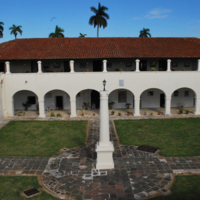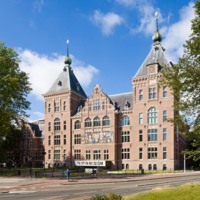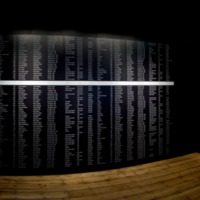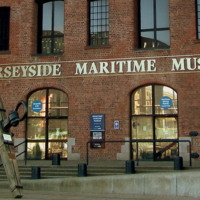
Museo Nacional Ruta del Esclavo
The Museo Nacional Ruta del Esclavo (Slave Route National Museum) is housed in San Severino Castle, in the Matanzas district of Cuba. It opened in 2009, as the product of UNESCO's Slave Route project. Off the beaten tourist track, the museum in the seventeenth-century castle receives few visitors.
The museum itself houses an important exhibition, aimed at showcasing the horrors of the Transatlantic Slave Trade in order to prevent the like ever happening again. The museum has four exhibition rooms with photographs, objects and archaeological items accompanied by interpretive text. These rooms address the origins of slavery, the plantation systems, abolition and emancipation, and the ongoing legacies affecting people of African heritage around the world.
After being selected by UNESCO to house interpretation for the Slave Route project, the museum has supported a number of African cultural groups in the local area, as well as hosting activities for the nearby university. In the exhibition space itself, there are fourteen African sculptures donated by Cuban artist Lorenzo Padilla.

Tropenmuseum of World Cultures
The Tropenmuseum of World Cultures (direct translation; Museum of the Tropics) is an ethnographic museum, founded in 1864. Housed in one of the 'most impressive buildings in Amsterdam', the museum features eight permanent exhibitions and a series of temporary exhibitions. The key theme of the museum is people, with all of the exhibitions making use of the museum's vast collections of over 150,000 objects, paintings and photographs, to showcase universal human themes, including celebration, mourning and conflict.
In the 'Afterlives of Slavery' exhibition, visitors are confronted with the legacies of slavery and colonialism in contemporary Dutch society. Developed in collaboration with scientists, artists and activists, the exhibition tells the history of slavery with the experiences of the enslaved, and their descendants, at its heart. Video portraits provide the perspectives of four key figures in the contemporary debates about colonial legacies for Dutch black people.
The key link between past and present here is the continuation of inequality and prejudice. Collections, both historic and contemporary, highlight this, as well as illustrating how times have changed. These include testamonies of enslaved people, books, portraits, 'relics of slavery' and examples of African art.

Museum of London Docklands
The Museum of London Docklands houses the Port and River collections of the Museum of London. The aim of these museums is to showcase the growth and development of London, from the Roman era through to the present day. In a period of expansion for the Museum of London, the Museum of London Docklands was opened in 2003 in a Grade I listed warehouse on West India Quay, the historic trading heart of London.
Due to its location in a warehouse which would very likely have stored sugar, and other slave-produced items, the history of the transatlantic slave trade and its impact on London fits well within this space. ‘London, Sugar and Slavery’ was originally produced in 2007 as part of the bicentenary commemorations but has since become a permanent part of the museum. The displays have a local focus, supported through a wide range of objects, and consider the impact of the slave trade on London historically and today.
On entering the gallery visitors are met with a list of ships that traded slaves from the West India Quay- placing them right there in the story. Next there are discussions of the economics of slavery, and indications of how the money made from it changed the city of London forever. The exhibition also includes discussions of resistance, and abolition- centring the movement on the mass movement in the wider population with a case entitled ‘Abolition on the Streets.’ To bring the display up to date there is a discussion of representations of black people in popular culture, with objects including children’s books, film memorabilia, toys and prints, in line with a further piece on racism in London.

International Slavery Museum
The International Slavery Museum (ISM) is the first museum in the world to focus specifically on slavery, both historical and modern. Managed by National Musuems Liverpool, it opened to great acclaim in 2007 and has since welcomed over 3.5million visitors. Through its displays and wide-ranging events programme, the ISM aims to tackle ignorance and misunderstanding in today’s society by exploring the lasting impact of the transatlantic slave trade around the world. On entering the ISM, visitors immediately arrive in a space designed to provoke thoughts and discussion- the walls are etched with powerful quotations from historical figures and contemporary activists, many from the African diaspora. There is a display of West African culture, designed to showcase the breadth and depth of African civilisation before the devastation caused by the transatlantic slave trade, which includes examples of textiles, musical instruments and other ethnographic material. The display then goes on to look at the trade itself; the logistics, the processes and who benefitted on one hand, whilst also exploring the experience of the enslaved through multisensory interpretive techniques, including an emotive film of what the Middle Passage may have been like. All of these displays are supported by the rich, local archival collections, drawing on Liverpool’s own history as a prosperous, slave-trading port. Moving forward along a chronological timeline, the exhibition then covers abolition, significantly beginning with the acts of resistance from the enslaved themselves, through to organised abolition movements and then discussing the continued fight for freedom through the post-emancipation then civil rights era, right into the twenty-first century. The lasting legacies of the trade are thoroughly examined, from racism and the under-development of African countries, to the spread of African culture and diverse nature of Liverpool’s communities. A unique feature of the ISM is its ‘Campaign Zone’, opened in 2010, which houses temporary exhibitions just off the main gallery space. These are frequently run in conjunction with campaign organisations and usually focus on aspects of modern slavery, highlighting to visitors that it is very much still a live issue and not one that has been relegated to history. Recent exhibitions in this space have included 'Broken Lives' organised with the Daalit Freedom Network and 'Afro Supa Hero' with artist Jon Daniels.